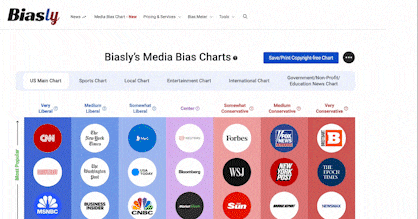
Bloomberg News is one of the leading voices on economic and financial news. It is often considered a leading voice in “just-the-facts” reporting and is a valuable news source for unbiased and solutions-oriented content. Is this reputation deserved? At Biasly, we make it our mission to hold all media outlets accountable for unreliable reporting, and we would hold Bloomberg News to the same standard. In this article, we will investigate Bloomberg News’s reliability and accuracy.
Does Reliability Matter?
Reliability generally refers to how trustworthy or accurate information, or in this case, a news source, is. This definition makes it clear why reliability is essential in media sources. If we can’t trust the things we read, then there isn’t much of a point in consuming content from that source, after all. So, how exactly can we gauge the reliability of a news source anyway?
There are several potential measures of reliability to look for when trying to determine whether a media source is reliable or not. Red flags for an unreliable article include unsubstantiated claims, facts dependent on other unverifiable sources, heavy use of opinionated language, and more. Some indicators of a reliable source, on the other hand, include things like:
- Absence of subjective/opinionated language in articles
- Credible sources cited (e.g., neutral sources, .gov, .edu websites)
- Facts and statistics backed by multiple relevant outside sources
- Use of primary sources when possible (e.g., interviews, quotes)
- Information that remains consistent across news sources
So How Does Bloomberg News Fare in its Reliability?
The political reliability index developed by Biasly objectively assesses news organizations’ accuracy and trustworthiness. Bloomberg News’ overall Reliability Score has been rated as ‘Good’ by Biasly. This rating is a weighted average of two distinct scores: the Fact Analysis and the Source Analysis Score, each evaluating separate components of Buzzfeed’s Reliability. When computing the article’s Average Reliability, the Fact Analysis score is more heavily weighted. These ratings are as follows:
Bloomberg’s Fact Analysis Score is ‘Excellent,’ which suggests readers can trust much of the Bloomberg content they see online. The Fact Analysis score focuses more on the accuracy of claims, facts, and sources presented in the article and any hints of selection and omission bias, which we will discuss further in the article.
Bloomberg’s Source Analysis Score is ‘Fair,’ which suggests readers can trust some of the sources, links, and quotes from the news source. Based on A.I., this score focuses on assessing the quality of sources and quotes used, including their number, lengths, uniqueness, and diversity.
Since these scores are based on averages and summations, each article will naturally be more or less trustworthy due to various contextually dependent factors. Perhaps an individual author who writes for Bloomberg is more or less biased, but according to Biasly’s metrics, the collective result shows that Bloomberg News is relatively reliable. In this article, we will investigate the supporting data that has allowed us to reach this conclusion and what you can do to search for trustworthy news.
Bloomberg News Accuracy and Reliability
Any news organization risks impacting its credibility if it does not conceal its bias or is brazenly partisan, and Bloomberg News is no different. We at Biasly can assess Bloomberg’s publications and determine whether they are in accordance with the facts. Do they support their assertions with evidence? Do they use reliable sources? These questions and more will be the subjects of our investigation. As part of our assessment, we will check for selection and omission bias.
Selection bias is when stories and facts are selected or deselected, often on ideological grounds, to create a narrative in support of the new sources’ ideology. Omission bias, on the other hand, is when different opinions and political views regarding a situation are left out so that the reader is only exposed to the ideological perspective supported by the author. It’s essential to keep in mind these two types of biases when trying to assess an article’s level of accuracy.
To evaluate accuracy, Biasly assigns a percentage score ranging from one to 100, with one being the least accurate and 100 being the most. These ratings weigh any assertions an article makes with the supporting evidence it provides and any reliable internal or external sources mentioned within the article. Biasly’s Media Ratings page has dependability and accuracy ratings for any newly released Bloomberg News stories. Bloomberg possesses a Good reliability score overall, but it is important to note that this score does not apply to every article. If an article possesses a noteworthy amount of omission or selection bias, then this can cause the article to be unreliable.
Analysis of Reliability in Bloomberg Opinion Pieces
It is always important to remember that opinion pieces are opinions. A columnist who writes for the Opinion section is explicitly called upon to give their subjective interpretation of a leading issue of the day. The goal is to give readers an appreciation of a wide variety of viewpoints; they are not necessarily to be trusted but to be considered and either accepted or rejected by the reader. By providing a range of opinion pieces from across the political spectrum, an outlet can be more assured that the reader will be that much closer to seeing the issues from every angle.
Like many other media groups, Bloomberg has a long-running opinion section that hosts various commentators. These commentators diversify the type of content that Bloomberg produces; yet, because Bloomberg has this reputation of impartiality, we must be extra careful when analyzing it. We must pay attention to selection and omission biases—what they choose to include and leave out. Often, what an outlet doesn’t publish will tell you the most about them.
Quality of Sources and Facts Used
For an example of how unreliability can manifest itself even in otherwise meticulously reliable publications like Bloomberg News, consider this article: “Desantis Orders Florida Schools to Teach Evils of Communism’ by Anna J. Kaiser. An outstanding example of the difficulties that arise from selection and omission biases, this piece (which somehow wasn’t part of the Opinion section) is rated at a staggeringly low 15% source analysis rating by Biasly. The article contains only three different sources and two short quotes from the same source. More extended quotes generally (though not always) point towards more reputable sources.
In this article, the author uses the following sources:
- Statement from Office of Florida Gov. Ron DeSantis (Conservative Leaning)
- An uncited factoid from PEN America claiming that “over 3,100 books were removed across 11 school districts between July and December last year” (Liberal Leaning)
- A data point from the 2022 gubernatorial election in Florida showing that DeSantis won 69% of voters of Cuban descent (links to an NBC News report) (Liberal Leaning)
The major problem with this article is that there aren’t enough sources to provide a balanced perspective. It is presented as fact-based reporting, simply notifying the reader that Gov. Ron DeSantis signed a bill in April 2024 requiring schools to “teach the dangers and evils of communism.”
The author cites this and other statements from the Governor’s office, including Desantis’ resolution to prevent supposed Communist influence in Florida’s schools. The statement from the Governor’s office is supposedly quoted in support:
“We will not allow our students to live in ignorance nor be indoctrinated by Communist apologists in schools.”
Unfortunately, the author does not provide a link to the Governor’s statement or the text of the supposed bill, leaving the reader in the dark as to what the text contains or, indeed, whether there is such a bill.
Furthermore, the article contains almost no quotations or sources. Besides the two quotes from the Governor’s office, one uncited fact from PEN America claims that censorship in Florida schools is well underway.
“…over 3,100 books were removed across 11 school districts between July and December last year”.
Unfortunately, there is little to go on for the reader interested in learning more about this bill, such as why this law is being implemented in the first place or where the initiative came from. This does not stop Kaiser from offering her speculation. She claims that this initiative is part of a broader stunt by DeSantis to appeal to conservative voters who support such efforts.
“Schools across the country have become a battleground for conservatives, heightening tensions in colleges and leading to book bannings in public schools.”
However, she doesn’t provide any direct sourcing for this claim, only listing the PEN America statistic. This seems to indicate the author’s bias, as it primes the reader to make the association between the bannings and the efforts of conservatives; the author does not provide any direct evidence that conservatives are responsible for the heightening tensions or that the book bannings are genuinely the results of their efforts.
Without any context or supporting statements surrounding the origins of or reasons for this bill, the author seems to be inviting the reader to fill in the gaps, priming the reader to interpret the text in such a way that they could be made to feel unfavorable towards DeSantis and the bill, as well as any conservatives who may have fair reasons for supporting the bill. A reader interested in learning about the bill’s contents or Governor DeSantis’ plans should be advised to look elsewhere. The article paints a non-holistic view without any contradictory points of view that might prompt the reader to think differently. Unsurprisingly, Biasly gave this piece a “Somewhat Liberal” rating.
Selection and Omission Bias
Opinion pieces often have factuality, sources, and selection and omission bias issues. Biased articles generally exclude helpful or relevant background information to slant their viewpoint in a particular direction. Bloomberg is usually considered a centrist outlet with no specific ideological leanings and is not thought of as having a specific incentive to publish in a particular direction.
Yet articles such as “DeSantis Orders Florida Schools to Teach Evils of Communism” prove that an opinion section can contain a range of viewpoints. We hope that the reader, armed with this information about typical indications of bias and truthfulness, will be better able to keep themselves informed about the events of the day.
So Is Bloomberg Reliable?
Ultimately, we must conclude that Bloomberg’s reputation for reliability is well deserved, with strong journalistic integrity and largely factual reporting, barring a few exceptions. Unfortunately, all media is bound to have a degree of bias. However, this should not dissuade interested consumers from trusting Bloomberg News. All we are saying is that one should not cease the conscious effort to understand everything that comes with analyzing bias, including sources, selection, omission, and factuality. Consider using Biasly’s News Bias and Reliability Checker to assist you.























